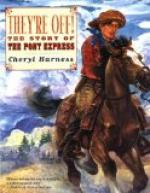Added to the perils of the wilderness deserts, blizzards, and wild Indians — the pony riders, then, had at times to beware of their white friends under such circumstances as have been narrated. And that added to the tragical romance of their daily lives. Yet they courted danger and were seldom disappointed, for danger was always near them.
[23] Root and Connelley.
[24] Pony riders often alternated “runs” with each other over their respective divisions in the same manner as do railroad train crews at the present time.
[25] “Wild Bill” Hickock was one of the most noted gun fighters that the West ever produced. As marshal of Abilene, Kansas, and other wild frontier towns he became a terror to bad men and compelled them to respect law and order when under his jurisdiction. Probably no man has ever equaled him in the use of the six shooter. Numerous magazine articles describing his career can be found.
[26] Inman & Cody, Salt Lake Trail.
[27] Bancroft.
[28] Indians would sometimes gaze in open-mouthed wonder at the on-rushing ponies. To some of them, the “pony outfit” was “bad medicine” and not to be molested. There was a certain air of mystery about the wonderful system and untiring energy with which the riders followed their course. Unfortunately, a majority of the red men were not always content to watch the Express in simple wonder. They were too frequently bent upon committing deviltry to refrain from doing harm whenever they had a chance.
Chapter VII
Anecdotes of the Trail and Honor Roll
No detailed account of the Pony Express would be complete without mentioning the adventures of Robert Haslam, in those days called “Pony Bob,” and William F. Cody, who is known to fame and posterity as “Buffalo Bill.”
Haslam’s banner performance came about in a matter-of-fact way, as is generally the case with deeds of heroism. On a certain trip during the Ute raids mentioned in the last chapter, he stopped at Reed’s Station on the Carson River in Nevada, and found no change of horses, since all the animals had been appropriated by the white men of the vicinity for a campaign against the Indians. Haslam therefore fed the horse he was riding, and after a short rest started for Bucklands[29], the next station which was fifteen miles down the river. He had already ridden seventy-five miles and was due to lay off at the latter place. But on arriving, his successor, a man named Johnson Richardson, was unable or indisposed to go on with the mail[30]. It happened that Division Superintendent W. C. Marley was at Bucklands when Haslam arrived, and, since Richardson would not go on duty, Marley offered “Pony Bob” fifty dollars bonus if he would take up the route. Haslam promptly accepted the proposal, and within ten minutes was off, armed with a revolver and carbine, on his new journey. He at first had a lonesome ride of thirty-five




